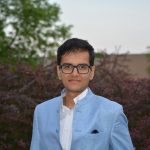 Janmesh Patel
Janmesh PatelHome Institution: University of Wisconsin, Madison
Status: Sophomore, Expected Graduation Date: May 2020
Field of Study: Biomedical Engineering with a Minor in Technical Japanese
Host Lab in Japan: Kyoto University – Institute for Integrated Cell-Materials Sciences (iCeMS), Kamei Laboratory
Host Professor: Prof. Kenichiro Kamei
Research Abstract and Poster: Optimizing the differentiation of hiPSC derived hepatocyte-like cells via mechanical stimulation (PDF)
Why Nakatani RIES?
The Nakatani RIES Fellowship is a unique opportunity for engineers to apply their skills and acquire new techniques while conducting hands on research abroad. I knew that this program was meant for me since I have had an interest in Japanese culture ever since I was a child. Watching Japanese animation as a kid was my introduction to Japan, but it wasn’t until I started studying Japanese in college that I truly became appreciative of the nation’s vast and rich culture. In college, I decided to study biomedical engineering, specifically tissue mechanics and biomaterials. My goal is to integrate my knowledge of engineering principles so that I can apply my talents in the medical field to advance the study of stem cells and other forms of regenerative medicine. Japan is one of the most technologically advanced countries in the world; the more I researched the nation, the more I came to realize that there were labs there that were on the forefront of some very interesting findings. When I came upon the Nakatani RIES Fellowship, I realized that this was a once in a life time moment to travel to Japan, improve upon my engineering knowledge, and receive financial support to achieve all my goals.
From a technical standpoint, the structure of the Nakatani RIES program is ideal for students who truly have an interest not only in research, but conducting research specifically in Japan. I appreciate the fact that the program is 12 weeks long; this will provide ample time to gain a deeper understanding of the Japanese lifestyle. In addition, the cultural orientation before departure and constant support while abroad are key features that solidified my belief that this program would be very beneficial in helping me to reach my goals. The program will also allow me to meet other students from across the U.S. that are also interested in not only scientific research, but Japan as well. I am very excited to meet the other fellows and make new friends while I participate in the Nakatani program. I know that this will be a truly memorable and rewarding experience.
Goals for the Summer
- I hope to improve my Japanese speaking skills enough to the point where I am confident enough to hold a conversation with the locals in Japan.
- I plan to explore various research labs and meet different professors in order to gain a better understanding of the lifestyle of researchers in Japan.
- I want to build new connections and make new friendships while participating in the program.
- I plan on immersing myself in the Japanese culture; at the very least I want to try new foods, update my wardrobe at the shopping districts, and go sightseeing.
Meaning of Nakatani RIES (Post-Program)
Nakatani RIES is a program that is of great benefit to future engineers in order to help them gain hands on experience on an independent research project with the guidance of a leading Japanese professor or researcher. This fellowship assists a rising freshman or sophomore in becoming more self-sufficient by introducing new challenges to overcome both inside and outside the lab environment. I was able to achieve my goals of increasing my knowledge with working with stem cells and creating a network of new friends with specialties in various sectors. This experience was a once in a lifetime opportunity to explore Japan thoroughly while simultaneously gaining experience with collaborating on a cutting-edge research project. I will forever be grateful for the knowledge I gained, the ability to explore Japan, the mentors I was able to meet, and the lifelong bonds I was able to form with both the US and Japanese fellows. Overall, the experience with the Nakatani RIES fellowship was amazing and there is no better way I could imagine spending 3 months of my time.
Research Internship Overview
While I was in Kyoto for the summer I conducted my research in collaboration with Professor Ken-Ichiro Kamei at the Institute for Integrated Cell-Material Sciences (iCeMS). My project dealt with optimizing the differentiation of human induced pluripotent stem cells to mature hepatocyte cells via mechanical stimuli. My direct mentor was Kamei-sensei and thus I really had the ability to gain plenty of knowledge when it came to microfluidics and stem cells. He would answer any question I had and was always willing to help me in any way possible so that my project would be a success. This project related to my personal interests since I had wanted to work with stem cells before joining this program, but I also gained some practice with 3D modeling since I worked on designing the microfluidic device that would be used to culture the developing cells. Working in an international lab was challenging at times and I would recommend that anyone who chooses to do so should learn the language of the host country in order to gain a better experience. The only person proficient in English in my lab was Kamei-sensei so when I wanted to converse with the others it was a mix of broken English and Japanese. However, I feel as if they helped me to improve my Japanese while in return I was able to help them practice some of their English. My research experience this summer has taught me that no matter how careful you are and how dedicated you are to the project, there is no guarantee that things will work out in such a short amount of time. The cells that I was culturing continued to die and thus I could not apply the physical stimulus treatment to the maturing cells. This helped me to realize that no matter how hard you work that there is still a little bit that is left to chance; that small portion can only be influenced by luck, but it is still imperative to give it your all until the very end.
My research lab resembled what one would expect to see more in an American lab as opposed to a typical Japanese lab. Kamei-sensei studied in California for several years and so I believe his style of managing a lab is heavily influenced by his time in the U.S. There is no sense of hierarchy and everyone is very relaxed most of the time. The lab itself even collaborates with other research groups within the facility and around campus frequently in order to build a sort of community of researchers. However, there are some differences and this comes into play when you look at the day to day aspects of the lab. The other researchers would work a very strict schedule of 9:00 am to 6:00 pm and interestingly everyday lunch would be at the same time (noon). They would also never really divert their attention from work even during lunch. This created a very quiet environment which is completely opposite to my experience in a U.S. lab. The other Nakatani fellows were placed in more “Japanese” style labs and based on their experiences there were many differences to be noted between the US and Japan in terms of lab culture. Regardless, the lab environment was very warm and welcoming and everyone made sure to make me feel as if I was a part of their group as opposed to just a visiting researcher.
Daily Life in Japan
Daily life while conducting research was very different from daily life while I was in Tokyo. During the orientation program in Tokyo the schedule was stricter and so there was not as much room to explore on your own. There was enough structure to guide our daily activities, but we still had enough freedom to explore the city. This was a nice transition into becoming almost completely independent once we got settled into our host cities, mine being Kyoto. The day to day lifestyle consisted of biking to the iCeMS facility, eating lunch at the cafeteria next door, biking back to the apartment complex, and occasionally walking to the Kawaramachi district (main shopping/tourist area) to spend the nights perusing around town. The bus system in Kyoto was very well developed and easy to use (still nothing compared to the unbelievable subway system of Tokyo). There were endless temples and shrines in the city at almost every turn. Some days I would just walk around town and visit some of these shrines since the architecture and scenery were breathtaking. The weather in Kyoto this summer was very extreme with an earthquake, typhoon, severe flooding, and then topped off with a heatwave. I really hope that next year the weather is milder! As I traveled in Japan I found that if you have a basic understanding/ability to communicate in Japanese then it will be much easier for you to enjoy all that the country has to offer. There were many times that I saw foreigners struggling to get their point across while trying to order food or finding their way around the city. I think the most rewarding aspect of my travels was getting the opportunity to talk with the locals especially at the smaller restaurants I visited. Overall, the daily life takes a little bit of time to get used to in your host research city since you are almost completely on your own, but the experience really helped me to stand up on my own two feet.
Experiences with Japanese Culture
My most meaningful experience with Japanese culture had to be the weekend Mt. Fuji Lakes trip that the U.S. fellows took with the 2018 Japanese Fellows during the Orientation Program. This was a great opportunity to bond not only with the Japanese students, but with the U.S. ones as well. I feel as if I was able to really understand the viewpoints of the Japanese students over the few days we spent with them. I am pretty sure that relaxing at the resort’s onsen also helped us to loosen up around each other. I will never forget the time I spent getting to know Katsuya and Shuhei since they were my roommates along with Lincoln. The four of us would play card games in the hotel room while talking about life, school, our interests, and other random topics. In the future, I hope that the future fellows (U.S. and Japanese) get an opportunity similar to this so that they can spend some time with each other.
- My favorite experience in Japan … had to be just strolling around the major shopping districts in the various cities I visited (Tokyo, Kyoto, Osaka, etc.). There were so many interesting products and anime memorabilia that I could spend hours just browsing different stores.
- Before I left for Japan I wish I had … packed some of my favorite snacks, especially protein bars because the protein products in Japan did not have much protein and they were quite expensive.
- While I was in Japan I wish I had … explored some more vegetarian options for food instead of just defaulting to Indian restaurants.
Excerpts from Janmesh’s Weekly Reports
- Week 01: Arrival in Japan
- Week 02: Language Learning & Trip to Mt. Fuji Lakes
- Week 03: Noticing Similarities, Noticing Differences
- Week 04: First Week at Research Lab
- Week 05: Cultural Analysis – Life in Japan
- Week 06: Cultural Analysis – In the Lab
- Week 07-08: Overview of Mid-Program Meeting & Research Host Lab Visit
- Week 09: Research in Japan vs. Research in the U.S.
- Week 10: Reflections on Japanese Language Learning
- Week 11: Interview with a Japanese Researcher
- Week 12-13: Final Week at Research Lab & Re-Entry Program
- Final Research Project Overview and Poster
- Follow-on Project
- Tips for Future Participants
Week 01: Arrival in Japan
The pre-departure orientation at Rice University had some very beneficial seminars that really helped me to transition more smoothly into Japan and to get me thinking about my work in the research lab in Kyoto. The most helpful discussion at Rice was the one with the panel of previous Nakatani students that completed the program. They provided some great insight in regards to what we should expect from our time in Japan as well as some tips on how to adjust to life in the country and interacting with the Japanese people in general. I really enjoyed the stories that they had to share on some of their favorite parts of the program and the most enjoyable moments that they had in Tokyo. Professor Kono’s introduction to doing research abroad and Dr. Gayle Moran’s introduction to poster design and development also helped to begin thinking about the project that I would be working on while in Japan. Professor Kono thoroughly described life as a researcher in Japan and he provided comparisons between research in Japan and America. He explained how the two countries differ in terms of the hierarchical relationship between varying members of the lab (for example the interaction between graduates and post-docs) in Japan. This is different from my experience in the U.S. because in my lab in America even if the members have different titles, the relationship between individuals is not completely influenced by the status or rank of each person. There is more of a sense of community as opposed to strict divisions in rank. As for the talk on poster design, I felt it was beneficial to gain more insight into the structure and content that should be added to scientific posters. Although I have prepared posters as a part of my coursework, I have yet to design a poster that will be presented to individuals that may have no idea as to the topic or basics of my research. I learned about some useful techniques in order to make my poster both informative and simple enough for the almost anyone with a basic scientific background to understand.
The moment that I arrived in Tokyo, especially during my first exposure to one of the livelier parts of town (Shibuya) I knew that I would have an unforgettable experience in Japan. I was shocked by the cleanliness of the streets and the relative lack of chaos within the city even though there were thousands of people walking on the streets at any given time. The stores and buildings were enormous and the staff seemed to be far friendlier and more inviting than anything you can find in America. Even once nightfall hit the town, the atmosphere never altered or settled down; on the contrary I think things got even more active. On the second day in Tokyo we all got our Suica or metro pass that would allow us to travel on virtually any subway or bus in Tokyo. At first understanding the subway/train system was a bit daunting of a task, but after the second day I had all the major routes memorized. After that I really began to enjoy Tokyo because I didn’t have to worry about getting lost and I didn’t have to constantly check my phone to make sure I was going in the right direction. Even though I have enjoyed almost all of my experiences in Tokyo to date, there have been some minor difficulties that I have encountered. The most prominent challenge that I am still attempting to overcome is trying to find food that can accommodate my dietary restrictions. I am a vegetarian and so much of the food in Tokyo is off limits for me. Honestly while going to restaurants and grocery stores I was surprised as to how much of the food includes fish broth (dashi) or fish powder. Almost all the food that I have encountered so far, excluding desserts and bread, have some sort of non-vegetarian element within them. I am, however, grateful to the grocery store staff at all the shops I have been to because they really do care about customer service. At one of the grocery chains, one of the employees even took the time to read the label of over thirty different pre-made meals in order to verify that they truly were vegetarian (sadly none of them were). In addition to many of the meals not being vegetarian, the produce in the country is also very expensive. The fruits and vegetables in Japan are far more expensive than their counterparts in the U.S. and they can even be in the hundreds of dollars depending on the quality and specific fruit (some of the melons I saw at an upscale market were selling for 500 dollars). The food predicament is one that I will have to work on while in Japan, but I am hoping that once I am in Kyoto I will have an easier time preparing meals for myself because at least there I will have a fully functioning kitchen. Even with the eating difficulties I am currently experiencing in the country, I do not feel as if this has at all negatively impacted my view of how amazing Japan, specifically Tokyo really is.
Since I have taken Japanese previously at my home university, University of Wisconsin, Madison, the language class I have been placed into is a bit higher in level than the other fellows. However, I feel as if this may add another layer of complexity into the learning process because at least for the beginners the instructors know they must start from the very basics. As for the other student in my class (Ben) and me, the sensei has a difficult time balancing the lessons since each of us know varying amount of Japanese. The class is made even a bit more difficult because we have had a different teacher almost every day this past week so it is hard to form a meaningful student-teacher relationship. From what I hear, the other Nakatani fellows are learning grammar, sentence structure, and hiragana/katakana (Japanese alphabet). In contrast Ben and I have primarily been focused on reading short stories and reviewing papers/articles related to our summer research projects and life in Japan. I have had some difficulty with the classwork and homework when it comes to reading kanji and understanding the vocabulary, but all the teachers have been very supportive throughout the entire process. Whenever there is a concept or word I don’t understand the instructors are always ready to help and explain everything slowly. In order to enhance my learning I am trying to use additional resources to help me increase/review some common Japanese vocabulary so that I can express my thoughts more clearly to the teachers. Overall, the structure of the language class encourages a deeper understanding of Japanese culture instead of just teaching us how to speak Japanese (but I do wish classes were a bit shorter!).
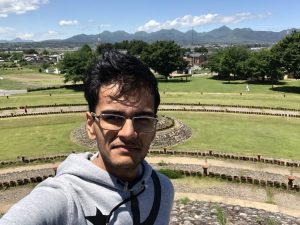
Over the past week, the other U.S. fellows and I have gotten the ability to participate in various activities organized by the Nakatani Foundation. We were able to visit the University of Tokyo on Tuesday and take a tour of the campus as well as many of Prof. Tabata’s research labs. The campus itself is very beautiful and peaceful in comparison to the hustle and bustle right outside the walls surrounding the school grounds. The lab facilities were also up to date for the most part. I was shocked at some of the lab practices, especially when we had to remove our shoes and put on different slippers to enter a few of the labs at the university. On Wednesday, the group went to Taiko drumming lessons and although I had fun, it was an unexpectedly exhausting hour and a half of almost non-stop playing. The seminar on the history of Sumo wrestling in Japan was interesting, but I am far more excited to see an actual tournament in the following week. The Ikebukuro Life Safety training center we went to on Friday was a nicely built facility that thoroughly went through what one should do in the case of an earthquake or fire emergency. The safety training was very engaging/interactive and I feel as if this was an important aspect in keeping everyone engaged. The site also had an earthquake simulator that I felt was a bit too realistic for my taste because even after only being exposed to a simulated magnitude 7 earthquake for 15 seconds, I was feeling nauseous and uneasy. This experience was worth it since I had never been in an earthquake before and this opened my eyes to how devastating and scary one can really be. On Saturday, we toured some archaeological sites in Takasaki; although I wasn’t too interested in the burial sites and museum tours, I did have a pretty memorable time. This was the first time that I got to ride in a Shinkansen or bullet train and the city of Takasaki was incredibly scenic and peaceful, a completely opposite atmosphere to the one in Tokyo.
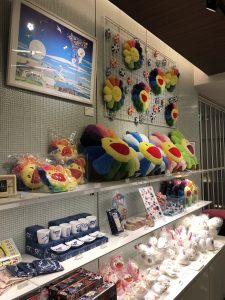
In addition to the group activities, I also had the opportunity to explore the city this past week with some of the other Nakatani students. I was able to travel to almost all the major districts within Tokyo at least once including Nakano, Shibuya, Shinjuku, Harajuku, Roppongi, Ginza, and Akihabara. In Akihabara I was able to go to Yodobashi Camera; this electronics store was massive and once inside it was chaotic. There were bright lights everywhere and all the shelves were stocked with random items ranging from electronics to stationary goods. I was also able to find some anime goods and figures while in this district as well, but I am sure I will be back since there is still much more Akihabara has to offer (like the maid cafes and costume karaoke!). In Shibuya, Shinkuku, Harajuku, and Ginza there were many shopping malls ranging from high end fashion stores like Dover Street Market to larger department stores. I browsed many stores in these districts, but there are still many things left to see and buy! I took a trip to Nakano this past week to visit the flower café of a

famous Japanese designer, Takashi Murakami. I enjoyed some desserts based off his artwork and I even came back with a pillow in the shape of his iconic rainbow flower design. Although I enjoyed every activity I participated in this past week, by far the highlight of my trip so far would have to be my visit to the Mori Art Museum on Sunday. The museum which is in Roppongi Hills had a Shōnen Jump exhibit to celebrate the manga company’s 50th anniversary. I had no idea that this titan in the industry was celebrating 50 years and I was left speechless when I found out that they had an exhibit currently going on with displays and merchandise from their anime projects from the 90s. Many of the anime I grew up watching were from the 90s and so it was like I was experiencing my childhood again. I felt like a kid as I saw the exhibits for some of my favorite anime like Slam Dunk, Yu-gi-oh, Dragon Ball Z, and Yu Yu Hakusho. There aren’t words to describe the joy I felt while walking through all the exhibits; this is one experience that I know I will always carry close to me and remember forever whenever I think of my first trip to Japan. The program activities and my personal adventures within the city were unforgettable and I can’t wait to see what the coming weeks will bring.
Research Project Overview
Prof. Ken-ichiro Kamei’s research interest lies in developing microfluidic platforms for applications in stem cells and cancer biology. He aims to recapitulate living systems by integrating microfluidic and stem cell technology for global healthcare. The overarching goal of his lab is to recreate a living system within a single device, known as the “Body on a Chip”. This in vitro recreation of the physiological and pathological conditions of the human body has the potential to be an integral tool in studying fundamental biological systems, assisting in drug development, and becoming an alternative to animal tests. With the integration of micro/nanotechnology with materials science, the function of cells can be studied via artificial cellular microenvironments. The lab’s specialized research topics include the “Body on a Chip” device, nanofiber matrices for scaled-up culture and transplantation of stem cells, a microfluidic platform for 3D cell/tissue analysis and culture, a PCP platform for spatiotemporal control of biocactive molecules, and to save endangered animals. As of now I am unsure of which aspect of the research project I will be addressing, but I believe it should relate to the “Body on a Chip” device in some way since this is at the center of the research interests for the Kamei Lab. I am eager to find out more about my research project once I arrive in Kyoto.
Prof. Kamei, along with other researchers, has recently published his findings on the effectiveness of an integrated heart/cancer on a chip to reproduce the side effects of anti-cancer drugs in vitro. Previous “Body on a Chip” (BoC) devices have been developed, but due to various limitations in terms of the extent to which a variable can be tested, there is much room for optimization. Dr. Kamei and his colleagues aim to address these issues with the Integrated Heart/Cancer on a Chip (iHCC) which offers cultures of cells of different tissue within a single device, an artificial blood circulatory system in the form of a closed circulation loop without the use of an external pump, and three sets of loops that can be used to apply different experimental conditions. The ability of this device to effectively mimic in vitro the conditions of the human body via simulated tissue/organ interactions is essential since it has the potential to limit or even eliminate human and animal drug testing. This technology could also significantly impact the field of personalized medicine by allowing the precise investigation of the effects of drug toxicity and efficacy based upon each individual. The numerous applications of this technology make the research in the Kamei lab very interesting since it has a direct impact in the pharmaceutical world.
Week 02: Language Learning and Trip to Mt. Fuji Lakes
Week 2 Overview
There were several group activities that I participated in this past week with the rest of the US Nakatani fellows. We went to the Japan Agency for Marine-Earth Science & Technology (JAMSTEC) institute on Monday where we were able to view their “Earth Simulator”. The company also has one of the best supercomputers in the world and we saw a model of the computer as well as the actual cooling mechanism for all the servers. After the visit to JAMSTEC, we went to Yokohama’s famous Chinatown (the largest Chinatown in the world) where we had a dim sum style buffet. Most of the entrees were non-vegetarian so I had to stick with unlimited desserts for the nearly three hours we were there. On Wednesday, we went to the Edo Tokyo Museum and the Grand Sumo Tournament. The sumo wrestling was exciting to watch, but the actual matches lasted only a few seconds. There were a few matches towards the end that were pretty intense because there was one wrestler who had been 10-0 undefeated so far in the tournament. It was also interesting to see that there were banners carried around the sumo ring before the start of the match; each banner indicated a sponsor and a certain amount of money that would be offered to the winner. The earlier matches only had a few banners since they were amateurs, but towards the end of the tournament when the pros battled, the sum of the prize money was in the thousands. On Friday, there was a seminar on the link between US and Japan throughout history via baseball. Although I am not a fan of baseball, the talk was very engaging due to the fantastic presentation given by Professor Sayuri Shimizu-Guthrie. She had a lot of humor and the talk was informative. In addition to the group activities, I also ventured out into the city once again on my own. I went to various shops and dessert restaurants in the major Tokyo districts just like in the first week. A memorable location that I visited was a thrift shop called Chicago. There were rows of vintage clothing items as well as numerous name brand merchandise all available for a very reasonable rate. The section of the store that interested me the most was the kimono area. The kimono sets were all beautiful and the price was not too high as well. This week was full of activities, but compared to the first week, I feel as if we dove more into the culture of Japan.
Weekend Trip to Mt. Fuji Lakes with Japanese Fellows
The Mt. Fuji lakes trip this past weekend was an amazing experience not only because of the beautiful scenery and sites to see, but also due to the fact that we had the opportunity to meet the 2018 Japanese Nakatani Fellows. Right from the beginning when we met them in the Sanuki Club lobby, their personalities were the complete opposite of what we had been lead to believe. I assumed that they would be more reserved and not use English as much. However, they mixed with us very well and their English-speaking skills were far superior to our Japanese language skills. The road trip to the Mt. Fuji activities was a prime chance for us to grow closer to the JP fellows and, as the weekend progressed, we soon became so close that even saying goodbye became difficult.
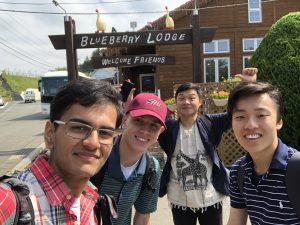
When we arrived to the Gotemba Kogen Resort I roomed with Katsuya, Shuhei, and Lincoln. Right off the bat I noticed the cultural difference between the US and JP fellows based on the way that each group interpreted casual dress. Most of the US fellows came in either jeans/track pants and t-shirts. On the other hand, the JP fellows, especially my bro Shuhei, were dressed very well: dress shirt and nice pants. The JP fellows cared much more about their appearance than the US fellows did; their take on casual would be closer to more business casual in the US. Aside from appearance, however, the JP fellows in my opinion were not too different from us. They participated in clubs, they had a passion to travel abroad, and they all had a strong interest in the sciences. The resort was a great bonding experience for us as Nakatani fellows. The resort buffets allowed us to sit with new people each time we ate, the onsen was a great place for the guys to just relax and chill together, and the shared rooms with the JP fellows allowed us to have the time to get to know one another on a smaller scale. My roommates and I stayed up most of the night playing various Japanese card games, courtesy of Katsuya. Even though the instructions were all in Japanese, Katsuya made a PowerPoint in English to help describe the concepts of each of the games we played. This is a point I would like to take special note of because I appreciate the effort the JP fellows put in to become friends with us. For example, though English isn’t their first language, they used it as much as possible even if they were talking amongst themselves; they made an active effort to include us in all their conversations. I had a lot of fun interacting with the JP fellows over the weekend, but I wish I had asked for their input on research labs in Japan. I should have asked about the lab culture and more specifically it would have been beneficial to gain more information on the Kansai region since my lab is in Kyoto. I did become good friends with Shuhei who is from Osaka so I can probably meet up with him once I get to Kyoto. Also, Mari who attends Kyoto University was very nice and I’m sure that she will help once I get settled into Kyoto. Overall, I enjoyed my time with the JP fellows, but I wish we could have had more than a couple of days to hang out. I am looking forward to meeting some of them in the Kansai region and the rest of them again at the mid-program meeting in Kyoto.
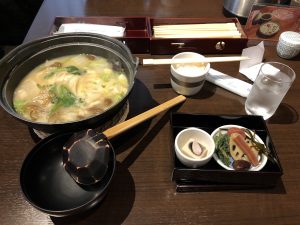
In addition to meeting the Japanese fellows, we were able to do a lot of sightseeing in the Mt. Fuji area. We went to the Kitaguchi Hongu Fuji Jinga shrine, the 5th station of Mt. Fuji, the Numazu Deep Sea Aquarium, the Mishima Skywalk, and we finished our trip with a strawberry picking excursion. By far one of the best experiences this weekend was the lunch we had at the shrine. This was the first warm meal I had since coming to Japan because of my vegetarian diet. The miso broth, the noodles, and the vegetables were a flawless combination and along with the presentation this meal proved to be a memorable one for me in Japan. The other highlight of the weekend was the Mishima Skywalk because the walk along the suspension bridge was both thrilling and a bit frightening. The extra activities that we participated were for the most part a very fun way to spend our time hanging out with the JP fellows and experiencing the natural beauty of Japan.
Question of the Week
What are some popular party/board games in Japan?
- See the section on Hobbies and Games in Japan on our Life in Japan resources page.
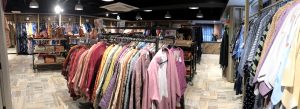
Introduction to Science Seminars
The introduction to science and engineering seminars this past week given by Professors Kono, Otsuji, and Saito focused on aspects of engineering that did not exactly correlate with the research I will be conducting over the summer. Professor Kono gave a couple of lectures going over basic physics concepts, Professor Otsuji explained his studies on terahertz coherent electromagnetic waves, and Professor Saito discussed his work on carbon nanotubes. Even though my research at the Kamei lab will focus on working with cells (as far as I know at this point) I did find the lectures very informative. I appreciate the fact that the lectures tended to complement one another and the information presented was both coherent and not too difficult to understand (at least the overarching themes were easy to comprehend). Once I do find out more about my project I will hopefully have the necessary knowledge to have a basic understanding of the materials I will work with.
Week 03: Noticing Similarities, Noticing Differences
My experience with public transportation in Tokyo has been completely different than in the United States. The subway and train system in Tokyo is almost fool proof and very easy to pick up in a short amount of time. Within a week, I was comfortable traveling alone anywhere in the city via the subway. The subway stations and the trams themselves are also much nicer than those in some of the other larger cities in the US such as Chicago or New York. The cleanliness in the trains in Tokyo is on a whole other level and the stations also feel extremely safe even late at night. In the US I don’t think I would ever go to a subway station late at night. In addition, the trains themselves aren’t the cleanest. I am sure you would need to have a lot of courage (or not care at all) if you were to just sit down in a New York subway train seat without checking if its clean first.
The differences in the atmosphere and upkeep of public transportation in Japan and America can be attributed to the culture and values of each country. The people of Japan are more group oriented and care about their appearance and if they are disrupting/inconveniencing others. However, in America there seems to be more of a focus on oneself. Therefore, I believe public transportation is not kept up to the same standards as that in Japan. If the people are too focused on themselves then they won’t worry about how their actions may negatively impact the experience of others. In America, this is the reason behind the prevalence of ride share companies such as Uber and Lyft. People are not willing to be mindful of others and share; as a result, in order to enjoy a peaceful, safe, and clean ride in the US you must book a private means of transportation. Furthermore, in Tokyo I noticed that no one on the train eats or talks on the phone (or with others on the train for the most part). The only exception to this rule is when I see foreigners breaking these “rules” on the train, but this usually only occurs near the Azabu-Juban station where many of the foreigners in Tokyo stay. Most of the time while on the train people are either fidgeting with their phones or they opt to read books/manga. The behavior of most of the Japanese passengers on the subways tends to remain the same regardless of the time of day or day of the week; they always try to minimize their presence while being mindful of others. Japan has one of the most advanced public transportation systems in the world and I believe that this is attributable to both the government and the mindset of the people.
Final Orientation Program Overview
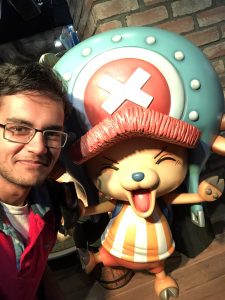
This past week we had a couple of free days on Monday and Saturday, but for the most part I decided to just relax instead of filling my day with things to do in the city. On Monday I went to the One Piece Tokyo Tower exhibit and on Saturday I went to Shibuya in order to see the One Piece character goods store. I feel like I spent both of my free days reliving my childhoods because I felt so happy and excited as I got to see so many One Piece related items. The exhibit was full of 3D sculptures, games, and a restaurant based off the show. The store in Shibuya had many exclusive One Piece products, many of which I decided to buy right on the spot because I was so eager to use them right away! However, now that I am reflecting on my free days I do wish I had packed them with more activities; I feel like it just hit me that I won’t be able to go back to Tokyo until the end of the program and even then, it will only be a couple of days.
I am happy that I made the most of my last day in Tokyo on Sunday. Instead of going with the rest of the group to the train station to catch the Shinkansen, I decided to do some last-minute shopping in Shibuya; this is where I got to try some of the best soft serve ice cream I have ever tasted. The culture seminar regarding Japanese culture and specifically the art of the kimono given by Ito sensei was the best lecture in my opinion given during the orientation program in Tokyo. Ito sensei has been all over the world and seen so many different cultures. His life story was so captivating and inspirational. He has a very admirable dream of reviving the kimono in Japan; in order to implement this idea, he has worked with a group to design kimonos for each of the countries in the 2020 Tokyo Olympic Games. The designs were so beautiful and he even made me more passionate about my plan to buy a few kimonos to take back to the US. The lecture on life sciences given by Nishikawa sensei was informative, but it focused more on philosophy and less on biology. The interpersonal communication lecture given by Ozaki sensei was a nice way to ask all the lingering questions we had regarding our omiyage and other concerns we had with beginning our work in the research lab.
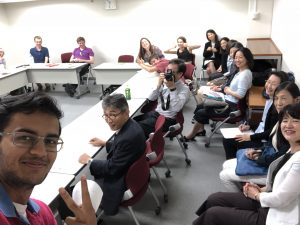
The language program in my experience could have been structured a bit differently. We had a textbook that we worked from, but I do not feel as if I learned anything new from going over the lessons from the book. Instead, I feel as if some of the other activities were far more beneficial. I enjoyed reading the lab websites for our research groups in Japanese as well as reading Japanese newspapers. This was a nice way to integrate our interests while improving our reading abilities since the topics were current and relevant. However, it was difficult at times to read the kanji unless the hiragana form of the word was written above. The best activity was when we would just talk about what we did over the weekend or what we were planning to do in the near future. This was such a fun way to practice our speaking skills as compared to just doing roleplay scenarios. Speaking was a bit awkward for me outside of the classroom setting; whenever I someone didn’t understand my Japanese the first time I usually got very self-conscious and immediately switched to English. My learning goal for the future is to become more confident in my speaking ability. I will try to find some other undergraduates on the campus to make friends with so I can practice my Japanese while having some company to chill with over the next couple months. Overall, the three weeks I spent in Tokyo were amazing and I am looking forward to experiencing new adventures during the next couple of months in Kyoto.
Question of the Week
Right before leaving the Sanuki Club to go to catch the JR line to Tokyo Station, I received a notification the subway line that I needed to take experienced a minor accident. Regardless of this fact, by the time I reached the subway station the line was running without a problem. I was wondering how are the subways so efficient and what happens in the case of a major incident?
- For more on this topic, see the section on Transportation in Japan on our Life in Japan resources page.
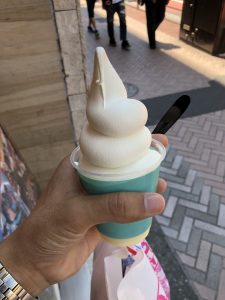
Intro to Science Seminars
The intro to science seminars were a bit difficult for me to follow and relate to this past week, as was the case during the seminars the week before. Most of the topics covered included information related to physics and material properties. The seminars given by Futaba-sensei was by far the most interesting one this past week because I enjoyed learning more about carbon nanotubes and their potential applications in the future. I was also intrigued by the path that lead Futaba-sensei to his current position as the leader of the carbon nanotube synthesis team at his current company. The presentation did not overwhelm us with too much in depth detail and thus it was relatively easy to follow compared to the other seminars given this week. Although I have little background on femtosecond lasers and phonons, I enjoyed listening to Ishioka-sensei’s talk; I especially appreciated the difficulties she went through in order to become such a successful researcher in Japan. Based on her lecture, it seems like the gender gap in the sciences in Japan is far worse than in other countries. As a result, she had to face many uphill battles in order to get to her position at the National Institute of Material Science. Her input on how to help alter the gender gap and the importance of inducing this change in the future was very helpful in explaining the reason behind the lack of female researchers in Japan. Overall, even though the physics based seminars given this week do not exactly relate to my field of interest, I had a lot of fun listening to the personal backgrounds of each of the researchers and how they ended up where they are now.
Return to Top
Week 04: First Week at Research Lab
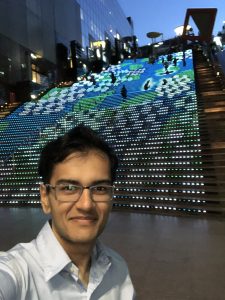
On Sunday, traveling to Kyoto was a lot smoother towards the beginning, but things became a little bit hectic once we arrived in the city. The Shinkansen ride from Tokyo was very easy and there was ample room on the train for baggage and leg space; I was also surprised at how far the chairs reclined backwards. Once I arrived in Kyoto I had to find my way to the hotel. The bus system in Kyoto is far more difficult to navigate than the Tokyo subway system since many of the stops and signs are exclusively written in kanji. The buses were also very cramped with all the bags we had to carry; it was a smart idea to ship the larger bags straight to the hotel (it was much worse when we had to also carry our luggage bags from the hotel to the apartment complex on the bus). Besides adjusting to the new transportation system, the travel was alright greatly in part due to google maps being such a useful app.
On Monday, I moved into the apartment complex in the morning, signed the paperwork, and immediately went off to lab. I met Kamei-sensei in the lobby of the iCeMS building and he gave me a quick tour of the facility. The first few days I just reviewed some literature and later in the week I began to work in the wetlab. The lab is quite small with three lab technicians, a secretary, and three part-time undergraduates. The only person in the lab that is fluent in English is Kamei-sensei and I anticipate that this may pose a problem in the near future. The other lab members understand English to an extent, but communicate almost exclusively in Japanese. I feel that it may be a challenge to ask questions or gain a better understanding of the rationale behind some of the experimental procedures due to this language barrier. I can speak and understand conversational Japanese, but there is no way I am fluent enough yet to understand or discuss science related matters. I will be working very closely with Kamei-sensei since there are no other master’s or PHD students or post-docs in the lab. On Friday of my first week the lab took me out for lunch at a middle eastern restaurant that served very delicious falafel. I really appreciate that Kamei-sensei asked me about my dietary restrictions before deciding on a place for lunch or else it would have been a little awkward if I couldn’t eat anything. I generally partake in small talk with the other members of the lab in Japanese and I know I can always turn to them for help if I have any questions while doing experiments. However, most of the time I am either reading literature or planning experiments.
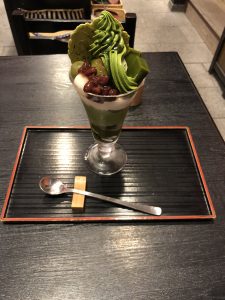
The housing situation is not the most ideal since it is formatted so that each tenant gets his own room with a bed, but the kitchen, bathrooms, and common space are shared among around 8 people. When I got to the apartment the fridge was already almost full with little room left for things I may want to buy, but the rest of the facilities were fairly clean; however, there is a cleaning schedule that was news to me. I don’t mind cleaning up after myself, but I didn’t plan on having to clean the toilets, bathroom, and kitchen for others as well. I much prefer the living situation I have in the states where each room has its own bathroom, kitchen, and toilet. Also, there is only one TV in the apartment that is situated in the kitchen on top of the dining room table. Ever since I moved into the apartment there has been one guy who has non-stop occupied the entire dining room table to watch TV. The TV is always on and he never moves from his spot. It’s a good thing that the apartment has Wi-Fi so I can watch shows on my laptop. The commute from the apartment to the lab is 20 minutes via bus (but to go one way is quite expensive at 260 yen) and the walk is 45 min. However, Kamei sensei was kind enough to let me borrow an extra bike he owns so this is what I will use to get around town.
My initial reaction of the town is that Kyoto is a very quiet city in comparison to Tokyo and this apparent right from the start since in my neighborhood almost everything was closed by 7 (even on the weekends). The only areas of town open late (to my knowledge) are Gion, Kawaramachi, and Kyoto Station. I have been so exhausted with adjusting to the new city and lab this past week so I haven’t done much exploring yet. On Saturday, Sahil, Ken, and I went to Kyoto Station for some dinner and to see the long staircase that lights up at night. During the upcoming weeks, we have plans to visit some of the temples and shrines around the region as well as do some shopping. I will work to build a more detailed itinerary in the next few days so that I have a general idea of all the things I want to see and do.
Reflections on Orientation Program in Tokyo
The orientation program in Tokyo was very beneficial in some respects, but there were elements that I found were not the most helpful. The best part of the program was getting to meet all the other fellows and spending time with them over the three-week period. I enjoyed learning about their research interests and why they chose to come to Japan. The seminars that we attended were nice, but most of them had very little to do with what my project would be addressing. The cultural seminars were far more interesting than the scientific ones and my favorite lecture had to be the one on kimonos/Japanese culture. The language classes helped a little bit, but I did not really learn new grammatical patterns or vocabulary; however, it was helpful to practice conversational Japanese with the AJALT teachers. I wish the classes were shorter so that there could have been more time to explore Tokyo. Now that I am in Kyoto I realize there is still so much more I wish I could have done while in Tokyo. During the orientation program, I was able to learn the lifestyle of Japanese people in a safe environment since I was almost always with a coordinator (Sarah san or Ogawa san) or one of the other fellows. A useful piece of information that I learned was that Japanese people appreciate their peace and quiet, especially on public transportation. I learned how to blend in more with the people of Japan and appear less as a foreigner; as I adopted more of their habits I began to notice the great extent to which foreigners behave differently in comparison to native Japanese individuals.
The orientation program helped me realize how much I truly value human interaction. Ever since I moved to Kyoto, I have felt a lot more isolated since almost everyone around me is new and they only speak Japanese. All the friends I made during the orientation program are now in different cities for the most part and there are no members in the lab that are near my age that I can converse with on a daily basis. I will have to adapt to this new lifestyle and once I began my experiments I feel as if this may become easier since I can devote more time to my work. Over the course of the summer I would like to investigate Japanese religion more on my own since I am in Kyoto, a town known for its temples and shrines. Overall, the orientation program a great opportunity to get adjusted to the Japanese lifestyle and to meet all of the other fellows: both Japanese and American.
Research Project Introduction
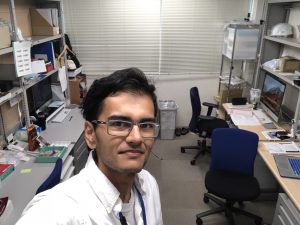
The Kamei Lab of the Institute for Integrated Cell-Materials Sciences (iCeMS) is a research group centered around Professor Ken-Ichiro Kamei. The lab is primarily interested in the control of the cellular, chemical, and physical microenvironments to investigate and direct the fate of stem cell definition. In order to manage these variables, the lab has developed a “body-on-a-chip” device to mimic the conditions of the human body in vitro. The unique aspect of this device is that it cultures cells in a 3D environment as opposed to 2D on a culture dish. Studies have shown that this 3D culture environment does improve the quality of the differentiated cells. The lab is working with both hepatocytes and cardiomyocytes from healthy or cancerous cell lines derived from human induced pluripotent stem cells (hiPSC). The lab hopes to optimize their current “body-on-a-chip” microfluidic device so that the hiPSC can be differentiated in a more controlled environment.
Under the direct guidance of Kamei sensei, I will be conducting research with hiPSC in an effort to differentiate them into mature hepatocyte cells over the course of roughly a 5-week period. Hepatocytes are responsible for many physiological conditions within the human body including drug detoxification, thus they are the target of many pharmaceutical drug screenings. Due to their importance in the medical field it will be beneficial to master their differentiation process from hiPSC so that in the future drug screenings can become more effective. In theory, the drugs could become specialized per individual if stem cells from the patient are used to cultivate hepatocyte (or other types of) cells. My project will be to complete the study that Kaylene and her graduate student worked on during the 2017 Nakatani Program. Kaylene was tasked with trying to find chemical compounds that would better assist the differentiation process. My task will be to further investigate the mechanical properties that affect the differentiation process. During the development of the embryo the liver and the heart are very close to one another. The beating of the heart is believed to influence the differentiation process of stem cells in the developing liver, in our case this affects the differentiation of the hepatocyte cells. In order to recreate this phenomena the “body-on-a-chip” has been optimized to incorporate a pressure system that will move the differentiating cells up and down in the microfluidic device. The 3D culture device will be assembled using polydimethylsiloxane (PDMS) that will be poured into 3D printed molds. The graduate student that worked on this project was not able to achieve enough replications of the experiment and thus could not reach a viable conclusion. Thus, by the end of my project I will need to have enough replications of the differentiation of hiPSC into mature hepatocyte cells so that statistical analyses can be conducted.
The rough design of the project is that I will culture the hiPSC on a 2D culture dish, 3D microfluidic device (without stimulus), and a 3D microfluidic device with applied pressure (with stimulus). The first two weeks of my stay at the lab will be focused on me getting trained in the fabrication process of microfluidic devices and on the procedure to culture hiPSC. The third week will be when I anticipate I will begin to culture my own cells and transfer them into the microfluidic device; the differentiation process takes about 25 days from hiPSC to mature hepatocyte. During the culturing period, I will also have to obtain training on either Labview or Biotray so that I can exchange the culture media and apply the air pressure to the treatment devices. The last week of my stay in Kyoto will be used to conduct statistical analyses. I will likely use real time quantitative polymerase chain reaction to compare the gene expression in the mature hepatocyte cells from the experiment to real primary hepatocyte cells. In theory, the cells cultured in the 3D microfluidic device with applied pressure will most closely resemble actual mature hepatocyte cells.
So far, I have learned how to use PDMS to fabricate template microfluidic devices and sometime this week I will be trained on how to make the device I will use in my experiment. Last week one of the lab technicians began teaching me how to prepare hiPSC for differentiation and this week we will begin the differentiation process. Overall, I feel as if I have a good understanding of the project and over the next week I hope to build up my confidence so I can begin to work independently.
Question of The Week
During the welcome lunch for my arrival into the lab, I was chatting with one of the undergraduates about her school life and classes. She said that they had about 20 classes per semester that were each 90-minute long. I was wondering how the course/credit system works here at Kyodai and how this compares to the typical layout of a semester in a US college?
- You may want to look into this Coursera course on ‘University Life in Japan’. You can also read more about higher education in Japan on our Life in Japan resource.
Week 05: Cultural Analysis – Life in Japan
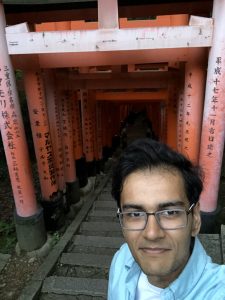
I was able to notice an interesting set of cultural differences when I went to the Fushimi Inari Shrine this past weekend. Since over the years this shrine has gained much popularity, it tends to draw large international crowds. However, even though so many people from around the world visit the shrine, many of the signs are posted only in Japanese (in some instances signs or warnings are absent). As I was climbing up to reach the top of the mountain where the main shrine is located, I noticed many foreigners who were clearly unaware of Japanese customs. For instance, usually there are fountains located in front of shrines so that people can wash their hands/face before praying. Along the path to the top there were many mini shrines that had smaller fountains that were releasing a constant stream of water into a container made from stone. Unfortunately, most of these fountains did not have any signs indicating what they were for. Thus, many unsuspecting tourists decided to fill up their water bottles or take drinks from the container. On the inside I was debating whether I should tell them that this water is probable dirty from people washing their hands. As I was trying to come to a decision, it was too late as one of the members of the group started to drink the water. At this point I decided that ignorance was bliss and I continued along the trail.
Another interesting experience was seeing how other people prayed in front of the many shrines located along the path to the top of the mountain. There were no clear signs or rules about how to pray; unlike us Nakatani fellows these people had never been told that there is certain way that the Japanese pray. It was interesting to see the ways that people were praying in front of the shrines: people would bow, put their hands together and pray, or even sit down next to the shrine to pray. Depending on the individuals’ background they prayed, I believe, in a way similar to how they would pray to their own gods. The final interesting aspect of the trip to the shrine was noticing how people didn’t seem to realize or appreciate the religious/historical background of the shrine. Many people were simply interested in taking photos or rushing to the top of the shrine. Maybe it’s just me, but I feel as if people should slow down and revel in the amazing architecture of the torii gates and all the shrines along the path to the top.
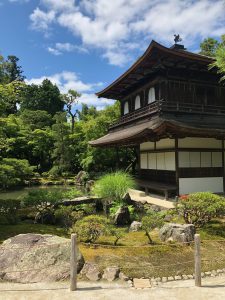
During all my experiences at the Fushimi Inari Shrine, I did not really interact with anyone, but I was able to learn a lot about cultural differences. From my visit to the shrine it is clear to me that when visiting another country, it would really be beneficial to learn some aspects of the culture. This will allow you to gain a deeper appreciation for the beautiful sites that you visit and possibly help you to avoid awkward mistakes such as drinking from a hand washing fountain!
Research Project Update
This past week in the lab I started the process to culture human induced pluripotent stem cells on my own. I performed the passage step last Friday. Now the hiPSCs will grow on a plate until Tuesday at which point they should be 90% confluent (cover 90% of the plate). I will repeat this protocol on Tuesday so that I can gain more exposure to working with cells since you have to be very careful to avoid contamination. I also finished 3D printing multiple microfluidic devices to be used for the hepatocyte differentiation experiment which I will start after the mid-program meeting. The upcoming weeks may prove to be a bit challenging since Kamei-sensei will be out of the lab for the majority of the time up until the Mid-Program Meeting. Therefore, I will have to communicate with the other lab technicians if I have any concerns with my project. I plan to work on developing another model for the microfluidic device to test alongside the model that has already been designed by the previous graduate student working on the project. This will take some time since I must first learn how to use the openscad modeling software (I have little experience with modeling software). I will also learn how to use the labview software to change the media and apply pressure into the microfluidic device when it comes time to execute the main experiment. Overall, the goal for the next couple of weeks is to hone my skills and prepare a new microfluidic device design so that I may begin testing in early July.
Question of the Week
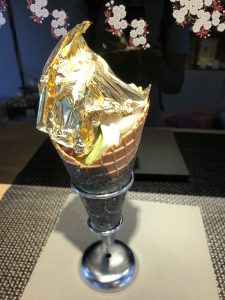
Even though I have made many purchases so far in Japan, I haven’t really considered how convenient the tax-free shopping has been. I was wondering why/how so many shops are tax-free and why don’t other popular cities in other countries adopt this practice?
- In countries where they use a value added tax (VAT) system you can often get a rebate on your sales tax but often this can only be done at a counter in the airport and you must individually save all receipts and ensure you do not open/consume the items you are seeking reimbursement of VAT for. For more on this, see this article by Rick Steves on VAT refunds when traveling in Europe and this article listing some other countries that offer VAT refunds. Policies and procedures do change, so its important to research the policies of the country/ies you plan to visit just before you go. Some countries, like the U.S., do not offer any sales tax refund for visitors as each city/county/state sets their own sales tax rate and there is no standard federal rate or reimbursement mechanism.
- In Japan, the in-store sales tax refund options have vastly expanded in the past 10 years in alignment with the massive increases in foreign tourists. The current tax-free shopping scheme in Japan was updated in 2014 and in 2017 expanded to include more consumable items. The process of claiming tax refund has also become much easier in Japan than it used to be just a few years ago.
- So today, it is very easy to apply for sales tax refund when purchasing total items of 5,000¥ at one time; provided you do not open/consume the items while in Japan and that you will be staying in Japan less than six months. Long-term foreign residents do not qualify for tax refund. For more, see the Tax-Free Shopping tab under Shopping in Japan on our Life in Japan resources page.
Week 06: Cultural Analysis – In the Lab
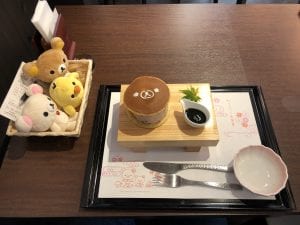
Within my research lab my interactions with the other lab technicians is always interesting due to the slight communication barrier that exists between us. My Japanese language skills are very basic and their listening/speaking comprehension with English could also be improved (although their reading/writing skills are very solid). The first couple of weeks I did not talk too much with the other technicians because Kamei-sensei was personally training me. However, this past week and the upcoming week Kamei-sensei will be out of town (or busy with meetings) and so the technicians will take over to finish my training. Most of the protocols that I have had to execute so far were written in English so there wasn’t too much confusion when it came to the overall procedure. The main difficulty arose when it came time for the detailed explanation of each of the steps. I really like to understand the purpose of each step and why/how it is used in the experiment. At first I tried to ask some questions regarding the protocol as the technicians were executing it, but the language barrier made it challenging for me to understand. After a few attempts I decided it would be best to try to find the answers online or wait for Kamei-sensei to return so I could ask him.
Even though the communication can be a predicament at times, everyone in the lab is always ready to help. For example, when I was having trouble adjusting the microscope zoom to view my cell culture, both technicians stopped what they were doing to help me out. I really do appreciate the team oriented mindset of the lab and their willingness to always lend a hand. Even though there have been some challenges with language, I feel as if the more I talk to them the easier it gets to communicate. We all try to use a mix of Japanese and English when communicating and I think it is starting to help me improve my Japanese as well as their English. I’m sure in the coming weeks communication will become easier.
Accomplishments and Challenges To Date
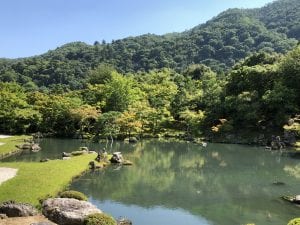
Adjusting to life in a new country or environment can take some time and getting used to, especially in a region where your native tongue isn’t spoken and you are the minority. Therefore, one of my biggest accomplishments, in my opinion, thus far has been to finally get into a routine here in Kyoto. After a few difficult weeks of adapting to living on my own in a new city, I feel as if I have settled down into my new temporary lifestyle. We aren’t long term residents of Japan, but at the same time we aren’t tourists. Thus, even though we will be leaving in about a month I think that establishing a sense of stability is important in order to maintain a healthy mind. I’m sure that our transition into our respective host cities is nothing compared to the challenges that some foreign exchange students or immigrants face when coming to the US (or any other country) since we have strong support from the Nakatani program, Ogawa san, and Sarah. However, this glimpse into the difficulties in adapting to a new culture will be very beneficial as it helps us to become more independent. Initially, I was having a lot of trouble trying to find vegetarian food, a stable means of transportation, and even finding miscellaneous household objects was a chore. Eventually, one by one I was able to get all of these tasks completed so that I could focus more on conducting research and enjoying the city of Kyoto. This accomplishment also leads into one of the biggest personal challenges I have faced thus far in Japan.
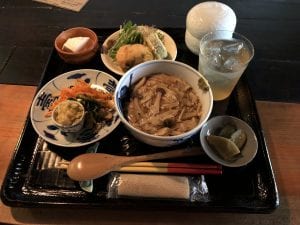
Now instead of worrying about my daily routine, I have begun to succumb to the feeling of loneliness here in Japan. Almost everyone around me speaks only Japanese and even in the lab I don’t really have anyone my age to talk with. I am really starting to miss my family and friends back home; even though I call them often, I still miss the feeling of being with them. The only times that I can hang out with someone is probably during the weekends when Sahil and I go explore Kyoto. I am really looking forward to the mid-program meeting because it will be nice to see everyone again; things will be a lot more lively and entertaining. Sometimes if I do feel as if I want to talk with someone in a language other than Japanese, I usually go to an Indian restaurant later in the evening. Most of the owners speak Hindi so it’s always nice to chat with them about their life and why they came to Japan. I have always wondered why foreigners who come to America (for extended periods of time) always seem to tend to eat food from their home country more often than trying new things. Now that I have experienced the phenomenon of being a foreigner I think I know the answer to my previous question. Whenever you miss home, one of the best and easiest ways to comfort yourself is to eat food or go to restaurants that remind you of your own culture. Although I have found ways to cope with this predicament, it is still ongoing and hopefully I will find ways to deal with this feeling in the coming weeks.
Research Project Update
My research project hasn’t actually begun yet since I am still going through the training protocols that I will need to utilize during my experiment. The past week I focused on culturing human induced pluripotent stem cells (hiPSCs) and passaging them once they became around 80% confluent (started new cultures from pre-existing cultures that had cells covering 80% of the dish). I also began working on designing a new microfluidic device to test alongside the model that the graduate student created last year. His device allows for the culture wells to be pumped up and down via pressure to simulate a beating heart. My design aims to include this pumping mechanism, but also allow for liquid to flow through the wells to simulate blood flow. The key to differentiating hiPSCs into mature hepatocyte cells is to mimic the in vivo conditions as closely as possible and this is what my device aims to accomplish. However, I am having trouble figuring out how exactly I will pump a constant flow of liquid through the wells. I will work on this aspect of the design this upcoming week. The next week I will also get trained on RNA extraction and working with Labview (a program to change the media and apply pressure to the microfluidic device). As of now everything is going according to plan so there are no concerns that I need to report.
Question of the Week
Japanese restrooms are some of the best I have ever seen; they are so clean and many of the toilets come equipped with bidets. However, I have been wondering why is it that most Japanese bathrooms don’t have hand dryers or paper towels? (My lab mates have told me that people usually just carry around their own handkerchiefs to dry their hands.)
- This is likely a combination of a cost-saving measure and a way to keep public restrooms cleaner. You won’t often find an over-flowing trash bin in restrooms in Japan and this is because people are expected to carry their own tenugui (small handtowel or handkerchief) with them to dry their hands. This is also a sustainable practice as it reduces the waste an individual produces on a day-to-day basis overall; similar to how U.S. students typically carry a re-useable water bottle with them.
- This is why under the Pre-Departure Resources: What to Pack section we suggest students plan to buy a tenugui from a 100¥ Store when they arrive in Japan and carry this with them in their back-pack/purse as it comes in handy.
- For more, see the section on Bathrooms in Japan on our Life in Japan resources page.
Week 07-08: Overview of Mid-Program Meeting & Research Host Lab Visit
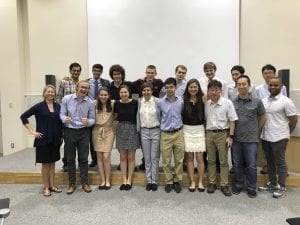
The Mid-Program Meeting was a nice break from feeling separated from everyone for over a month. I was very happy to get the chance to hang out with the other US and Japanese fellows for a few days. The travel to the hotel was very simple since it was only about 15 minutes from where my apartment is. It was convenient that I didn’t have to pack my bags and travel to another city, but it would have been fun to experience a different city in Japan for a few days. The most beneficial part of the meeting was the presentation portion because it gave me a chance to brush up on my public speaking skills. The meeting also helped me to better understand my project and it made me realize that I need to simplify my explanations more so that everything is easier to grasp for the audience. I really appreciate the yukata that we were given as gifts by the Nakatani Foundation and I had fun wearing it around town.

The Japanese Fellows were only around for a couple of days, but I had the opportunity to hang out with Shuhei and Katsuya again which was a lot of fun. The three of us along with Lincoln went out to a maid bar the night we received our yukata gifts and let’s just say it was an unforgettable experience. The night before all the fellows (both US and Japanese) went to a karaoke club and I feel as if this was a nice bonding experience for all of us. I will really miss spending time with the Japanese Fellows, but at least a few of them live close to Kyoto so maybe I will make plans to meet up with them again. Overall, the mid program meeting went smoothly and I can’t wait to see everyone once again in Tokyo in about a month.
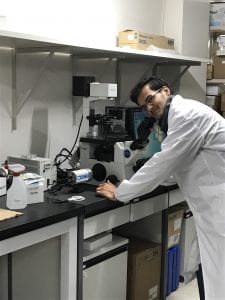
Research Project Update
The past few weeks of my project have primarily been training and preparing for the actual experiment. I practiced both cell culturing and RNA extraction from cells. In the following weeks, I will fabricate microfluidic devices so that I can begin to culture the hepatocyte cells starting from day 12 (a lab technician usually keeps a stock of cells at day 12 of differentiation). I need to try and devise a strategy to prevent the cells from dying on the devices or else the experiment cannot be conducted. The two ideas I will test out will be to thoroughly clean the 3D printed molds and I will also coat a few of the 3D printed molds with platinum to prevent any residue contamination on the PDMS. The other step I have to work on is programming the pump system that will apply pressure to the devices so that the wells move up and down to simulate a beating heart. This next month will really be challenging and I will have to focus very hard and plan everything out in a detailed manner.
The end of this past week starting from Thursday the 5th up until Saturday the 7th had some very intense rainfall here in Kyoto. There were constant alerts and many trains/subway lines had to be shut down due to flooding. Unfortunately, last Friday was when Sarah and Ogawa san had to come to Kyoto for the lab visit. The weather was unrelenting, but they still managed to get to the iCeMS building on time for the meeting. The mid program meeting was hosted in Kyoto earlier last week and the presentations were at the iCeMS building; therefore, Sarah and Ogawa san had a good idea of the layout of the building since everyone was given a tour of the facility at the meeting. I filled them in on some updates to my project, we discussed my thoughts on research both in general and conducting it in Japan, and then we concluded by taking some photos in the wetlab where I work.
Question of the Week
People in Japan are very serious about the way they handle trash. There are several different bins for trash based upon the category. Even in the apartment I am staying at we must separate our trash. I was wondering how this process all got started and what motivates the people to be so careful about the way they handle their waste?
- For more on this, see the section on Trash and Recycling in Japan on our Life in Japan resources page.
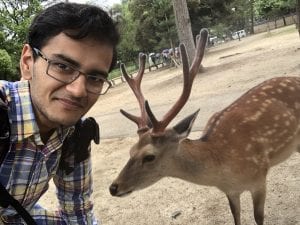
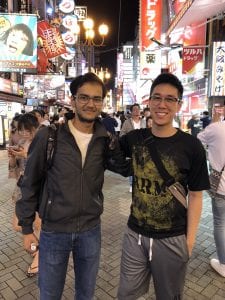
Week 09: Research in Japan vs. Research in the U.S.
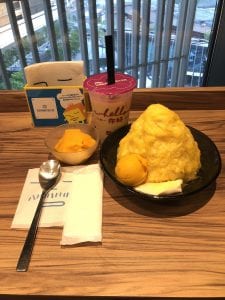
The Kamei lab here in Japan certainly has its differences from the Newmark lab that I am a part of in the United States, but for the most part the labs are very similar. This may be attributed to the fact that Kamei-sensei had studied in California for several years in the past. His experiences in the U.S. might be influencing the structure of the lab and the atmosphere he aims to create for everyone conducting research with him.
The typical work day at the Kamei lab is from 9 am to 6 pm, but this only applies to the lab technicians. The undergraduates and Kamei-sensei work irregular hours and can come in earlier or stay way later than the “normal” working hours. In my lab back home the hours are much more fluid. People can be found conducting research nearly anytime within a 24-hour window some days. I can admit even I have spent a few nights at the lab finishing up work on some projects.
The Kamei lab is a very small lab with only four actual researchers (including Kamei-sensei) and a few undergraduates. I feel as if this may play a role in the lack of a hierarchical structure. Therefore, when addressing one another there aren’t any formalities or barriers. In the lab it appears as if the small size is the key factor in preventing it from becoming more of a typical Japanese lab that many of the other fellows are a part of. The lab members are very collaborative with one another and whenever there is a disagreement, the problem seems to solve itself through a simple discussion of the issue.
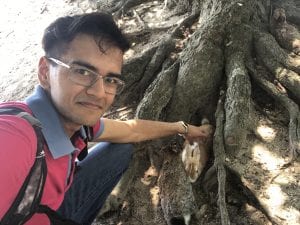
The expectations in the Kamei Lab are very similar to those in the Newmark Lab at the University of Wisconsin, Madison; the researchers have their own independent projects that they should be working on, but collaboration is highly encouraged. For example, while working on my project here in Japan, there isn’t anyone looking over my shoulder at every move I make. Kamei-sensei trusts me enough to make my own decisions and whenever I have a question he is more than willing to help in any way possible. The values in terms of academic research I believe are the same in Japan and the U.S. The researchers aim to gain as much knowledge as possible in their respective fields through their collaborations within their own labs and other labs. However, in the U.S. I think there is more inter-lab communication via seminars and collaborative efforts in comparison to labs in Japan. The end goal for both researcher in Japan and U.S. is to publish their research, but in the Kamei lab since there aren’t any graduate students or post-docs this is less apparent. Overall, my time at the Kamei lab has been very nice and productive due to its similarities to the Newmark lab and thus I was able to better focus on my project instead of also having to adapt to major cultural differences.
Research Project Update
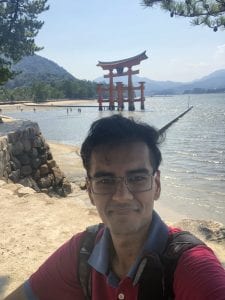
My research project is going according to schedule so far and I should be able to begin the cell differentiation process early this upcoming week. The differentiation will ideally proceed for 12 consecutive days at which point I will be able to collect the samples and analyze the RNA via real time polymerase chain reaction. I have to finish fabricating the microfluidic devices on which the cells will be cultured and assemble the holding container for the devices. Last week I worked primarily to plan my experiment by familiarizing myself with the BioTray pump system that will be used to apply mechanical stimulus via pulsations of the gel on which the cells adhere, running a preliminary test culture of hepatocytes on two devices, and beginning the fabrication of more devices for the actual experiment. The main concern that I still have is whether the cells will adhere properly to the microfluidic device. When I viewed my sample cultures last week many of the cells were not adhering (around half). I have made a few modifications to the experimental protocol and hopefully these changes will be enough so that I have a sufficient number of adhering cells to run an analysis on in the end. As long as I am able to monitor the cells closely, there should be no major problem once the experiment begins.
Question of the Week
In Japan, I have noticed that when it is noon almost everyone stops work and heads out to lunch at almost the exact same time. A restaurant can be empty at 11:45, but in a matter of minutes it becomes packed. In the U.S. people usually have a wide range of when they will eat lunch. I was wondering why it appears as if most people in Japan eat lunch at precisely 12?
- Yes, meal times are definitely more structured/fixed in Japanese workplaces than in the U.S. today. Most companies will adhere to the typical 9:00 – 5:30 PM work schedule and have a very strictly enforced lunch-break period. If employees leave earlier or return later, their pay may be docked. When all employees start and end work at the same time it is much easier for a company to set fixed break and lunch time hours. Companies in the U.S. that have set/core working hours for all employees also tend to have more fixed lunch time periods. Though, since flex work times are so common in the U.S. today, most office/professional workers set their own lunch breaks or just eat lunch at their desk while they keep working.
- Japanese workers also value lunch time as a time of rest and recovery in their day and most will leave the office or their desk for this break period.
- Also, many restaurants will have set-lunch menus that may be a bit cheaper than their regular menu but that are only offered for a fixed period of time or that are only offered until they run out. So, the structure of how restaurants serve/charge for lunch also reinforces many of these same societal norms and company policies. For example, here’s a list of 8 Michelin starred restaurants in Tokyo that offer discounted lunch sets.
Week 10: Reflections on Japanese Language Learning
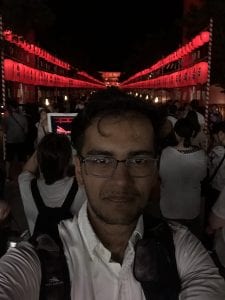
I have to admit that with everything going on with the lab and my interest in exploring the cities of Japan, that I have not devoted much time to exclusively sitting down to study Japanese. My language skills have improved slightly with my daily conversation with my colleagues in the lab. They are a bit shy about their English skills, but they always try to use it so that I can better understand what they are trying to tell me. Thus, I also feel that I should practice my Japanese with them as a sign of appreciation for them using English with me.
Occasionally I will look up some words that I do not know, but the main improvements that I have made are in my confidence in conversing in Japanese. Early in the summer I was very nervous about using my Japanese with anyone, but now I make it a point to always initiate the conversation in Japanese with people I meet. To be honest I have not faced any language difficulties while in Japan. The only slight challenge I faced was adjusting to an all Japanese lab, but I was able to get used to it fairly quickly. In addition, most of the important lab procedures/protocols are written in English so communication in regards to my experiment has not been a problem either.
My experience in Japan has made me want to focus more on the conversational aspects as opposed to reading and writing. Although I still want to improve my understanding of kanji, I feel as if increasing my vocabulary should be my priority. I know enough to form sentences and convey my thoughts, but at times I am at a loss for words due to my limited vocabulary. Japan is a fantastic country that I want to visit as much as possible in the future and thus I am motivated to increasing my speaking skills so that I can better enjoy my time in this country.
Research Project Update
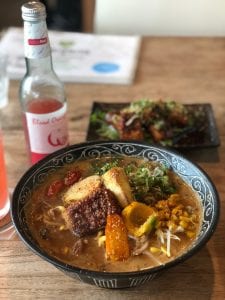
As of last week, I have run into many complications in regards to my research project. I was having some difficulty setting up the pump system that will apply the mechanical stimulus to my microfluidic device, but eventually late into last week Kamei sensei was able to help me solve this issue. The main concern that I have is that my cells that I am culturing on the microfluidics keep on dying. The longest that they have survived is three days, but eventually they just detach and die. The problem I believe is that the cells are not properly adhering to the PDMS surface of the microfluidics, but I am unsure as to why. The issue can originate from many sources such as the coating procedure of each well, the quality of the cells that were used from the frozen stock, the chemicals residues left on the PDMS after removing it from the 3D printed mold, etc. On Monday of the following week I will check on my cell culture that I started on Friday and hopefully they are still alive. If the cells are dead then I will have to rethink how I will spend the remainder of my time here at the lab. I believe the most beneficial contribution I can make is that if I devote my time to trying to figure out how to culture these cells on the microfluidics because even the other technicians are facing difficulties. Overall, I will hope for the best, but prepare for the worst-case scenario.
Question of the Week
I went to an arcade recently and they had seemingly endless rows of crane games. I tried out a few different variances of the game, but as expected they were very difficult to win at. In the U.S., we barely have any of these machines since people know the chances of winning are minimal. I was wondering why crane games are so popular in Japan because it’s obvious that they appear to be designed so that you can almost never win the amazing prizes that they flaunt inside.
- In the U.S., crane and arcade games are typically marketed to and though to be things played by children and young teenagers. However, in Japan, arcades and crane games have a much wider market and you can find people of all ages playing arcade games, though it does still tend to skew towards the teens and 20s age ranges.
- In the U.S., we typically only play crane games as children while waiting to be seated at a table at a restaurant, and usually just want to get the ‘cool’ prize. Because these are incredibly difficult to win, we easily get frustrated and, therefore, most adult Americans really hate crane games due to these disappointing/frustrating experiences as kids.
- In Japan, it may not be about the prize, it may be about being the one person who is skilled enough to win. Kind of how many Americans spend insane amounts of money on carnival games at State Fairs, even though they know the games are rigged and incredibly difficult to win.
- See also some of the articles on video games and arcades in the Hobbies in Japan section of our Life in Japan resources page.
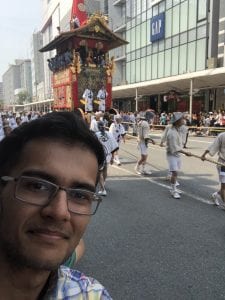
Week 11: Interview with Japanese Researcher
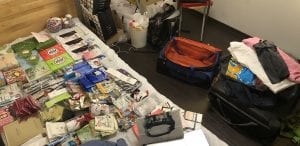
This past week I was able to interview Dr. Asuka Morizane of the Center for iPS Cell Research and Application (CiRA), a research institution here in Kyoto that is located near the iCeMS building. Dr. Morizane was originally a practicing neurosurgeon before he decided to devote his efforts to academic medicine and CiRA. He wanted to impact the world of medicine and was drawn to study neuroscience due to his fascination with the intricacies of the brain. However, when it came time to decide which path to follow he ended up going with his gut feeling to work in academics. He did tell me though that if I asked him a little over a decade ago the answer might have been different as to which path he would choose.
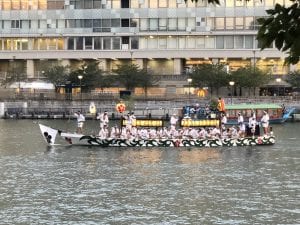
Like iCeMS, CiRA is an international research institutions with both principal investigators and the researchers coming from diverse backgrounds. Therefore, much of the lab culture that Dr. Morizane described reminded me more of a typical U.S. lab as opposed to a Japanese one. Dr. Morizane has some research experience in Sweden, but besides that he has spent most of his life in Japan. He is strongly in favor of international research and he even believes that the U.S. is the best country in the world for gaining this experience. He advised me to think carefully about the path that I want to take and consider all my options before making a decision; the life of a researcher can be challenging at times and the rewards of your hard work are not always immediately apparent.
As for the student interview, I decided to chat with the three undergraduates that come to my lab a few times a week to work on their own mini projects. They are each majoring in a biology related field and aspire to continue their work in medicine post-graduation. Collectively they would love to gain some international research experience, specifically in the U.S. After my interviews, I felt lucky being a researcher in the U.S. I have really come to appreciate many of the nuances that I have taken for granted thus far. The other undergraduates were fascinated with the research environment as well as the school life in the U.S. We discussed several topics such as coursework and lab culture.
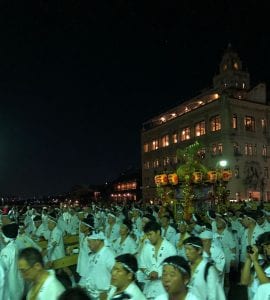
Through the interviews with the undergraduates and Dr. Morizane, I have come to understand how individuals view research in another country and their input on the U.S. These interviews have been very informational and helped me to broaden my scope as to how different cultures can impact the research and schooling environments.
- For more on the role of informational interviews in networking and why these are important for graduate students see the topic ‘Networking, Conferences, and Information Interviews’ on our graduate school resources page.
Question of the Week
In regards to the weather in Japan, specifically Kyoto, this summer has been brutal. There has been an earthquake, a typhoon which brought massive flooding, followed by a heat wave. I was wondering if this type of weather is normal for the summer and what is the most popular time for tourists to visit the Kyoto region?
- Japan is a nation that due to it’s geographical location is always at risk of natural disasters such as earthquakes and typhoons and this has actually had a role in shaping its society and culture too. As noted by the Gert Hofstede Cultural Dimensions, Japan’s high score of 92 on Uncertainty Avoidance has been influenced by the very real need to always be prepared for a possible disaster. Arising out of this, Japan actually has one of the most well-developed and well-trained emergency response networks and is a world leader in disaster response. This is also why almost every major city (and often even smaller districts or towns) have very detailed disaster response guides that have been translated into English and you can find links to many of these on our Safety in Japan page under the section on Natural Disasters.
- That being said, the summer of 2018 was a particularly brutal for Japan and the Kansai region got the brunt of the worst of earthquakes, flooding, and tsunamis this year. While it is always very hot and humid in the summer in Japan, particularly in Kansai, the heat wave that followed the July flooding was exceptional. Summer is high tourist season in Japan and other places like Europe that also often face deadly heat waves; likely because school holidays tend to fall over the summer months making it easier for families to travel. However, Kyoto is a tourist hot spot year round with many tourists in the spring to see the cherry blossoms (sakura) and the fall to see the changing colors of the leaves (momiji). So, truthfully, winter may be the only true slow tourist season in Kyoto.
- It is, usually, not this bad but Japan is a nation that is at risk for being right in the cross hairs of weather related issues due to climate changes such as longer and hotter summer and stronger typhoons due to rising sea temperatures (warm water is what a typhoon or hurricane needs to grow in size and strength). This is also true of the Gulf Coast in the U.S. and in the summer of 2017 the Japanese students who were in Houston had to deal with the effects of Hurricane Harvey which led Rice University to shut down for one week. The reality is that the weather patterns are changing worldwide and that any city or country that is located close to oceans will be more likely to feel increasing effects from rising temperatures and sea levels worldwide. That may be a controversial statement, but over the past 13 years both Japan and Houston/the Gulf Coast have all seen the frequency and severity of tropical storms and hurricanes/typhoon increase. This is why being prepared for these disasters is even more important today and Japan definitely is at the cutting-edge and America has a lot to learn from Japan’s preparation for and response to natural disasters.
Research Project Update
My research project is wrapping up now and since my original project was unsuccessful, much of last week was spent trying to figure out why the cells would not attach to the PDMS surface. Based upon my comparison between culturing HepG2 and hiPSC derived hepatocyte-like cells, it seems as if the latter are weaker since under the same conditions my HepG2 cells are adhering to the PDMS. I will further investigate this phenomenon this week while updating my poster and lab presentation.
Return to Top
Week 12-13: Final Week at Research Lab & Re-Entry Program
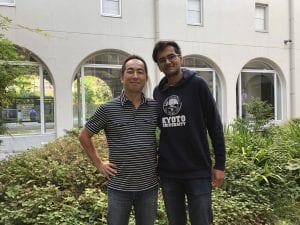
My final week at the lab was a bit frantic because I was attempting to finish up data collection from the HepG2 and stem cell derived hepatocyte cultures I had started the previous week. I took photos of each of the cultures to include in my presentation to show that the HepG2 cells could survive on the PDMS microfluidic device and thus the problem with culturing the hiPSCs did not have to do with my technique or microfluidics. I also set up the pump system to apply the pressure to each of the wells once the hiPSCs can be successfully cultured on the microfluidics. I left detailed notes and models of the microfluidics so that the next lab technician that will take over the project has a good basis to start from. I want to keep in touch with Kamei-sensei since he is very knowledgeable on stem cells and I am genuinely curious as to how the project develops.
Before I left Kamei-sensei and the rest of the lab took me out to a very nice Italian restaurant for lunch. That same day I gave Kamei-sensei a thank you note and I thanked the rest of the lab before leaving for Tokyo. I will forever be grateful for the opportunity Kamei-sensei gave me to work alongside him and gain exposure to culturing hiPSCs.
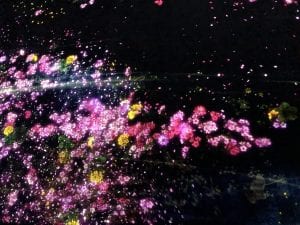
The final weekend in Japan was very busy. I first went to the that was temporarily open in the Odaiba district of Tokyo; the artwork there was breathtaking and I am so happy I found the time to go. Next I decided to climb Mt. Fuji with some of the other fellows, but I was severely underdressed. If it weren’t for Kaitlyn and Ken, then I would have been a popsicle at the summit by the time the sun rose. The next day I went to the Mori Art Museum in Roppongi to view the Jump 50th anniversary exhibit. There were displays of all of my favorite anime characters that I used to watch growing up; there is no other way I would have chosen to spend my final day in Japan. I feel as if the final week was a blur since there was so much to do in such a short amount of time.
Re-Entry Program at Rice University
Compared to when I first came to Japan, I feel as if now I am a bit more practical and reasonable when it comes to expectations. Originally, I had thought that everything would go smoothly with my research and that I would make stellar findings. However, after the several weeks I spent working with Kamei-sensei I have learned that no matter how hard you work or how optimistic you are, there are some things that just can’t be controlled for. I gave it my all while conducting my research, but there was nothing more I could do in the limited time I had to troubleshoot why the hiPSC derived hepatocytes weren’t properly adhering to the PDMS microfluidic device. My attitude towards Japan has changed in the sense that I am even more fond of the country after spending a few months studying there. I am just in awe of the deep culture embedded within a country that is also so modern and technologically advanced. The people are also very respectful and kind; they make you feel welcomed and important. There are so many things that I have to still see in Japan, I am just waiting for the day that I can go back.
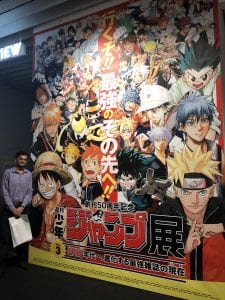
My attitude towards the US has not changed that much at all; after the couple of months in Japan I just came to realize that no matter how much I love to visit other countries, the US will always be home. The US has aspects from several different countries since the population is so diverse, especially compared to Japan. Furthermore, I am just so accustomed to the lifestyle in the US that I don’t think that I can live anywhere else for too long. However, there are many things that I miss about Japan and that I wish were present here in the US. I feel as if I will miss the Japanese culture the most. This includes all of the ancient customs as well as the modern ones. The temples and shrines were so beautiful in Kyoto and the anime/technology in Tokyo was so eye-catching.
The most common daily frustration I had in Japan was figuring out what to eat and how to cook dinner. I did not really enjoy the shared kitchen, especially since every time I wanted to cook, someone else was using the materials. Finding pre-made vegetarian meals was also difficult unless you had a lot of money to spend since the vegetables and fruits could get pretty expensive. However, I was able to learn to adapt my diet to the new environment. I was also motivated to wander the city of Kyoto more in an effort to find some affordable and delicious vegetarian food.
The most beneficial session at the re-entry program was the one where we all talked about things we missed in Japan compared to things we look forward to doing in the US. I feel as if this was a nice activity to reflect on our summer while attempting to move forward and apply what we experienced to help us in the future. The Nakatani RIES Fellowship has really made me consider whether or not I want to pursue academic research in the future. I am not really sure that the lifestyle of a researcher is for me. I feel as if after further exposure to research in the US my ideology might change because in Japan research life was quite isolating especially since the others in the lab spoke primarily Japanese.
Reflections on the Program Overall
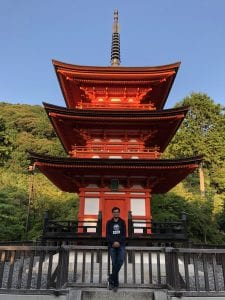
The Nakatani Fellowship was an amazing experience since it was able to expose us to Japanese culture, the life of a researcher, and it made us more independent since we were placed in a new environment while not knowing anyone in the region. I have nothing but praises for this program and I cannot be thankful enough that I was chosen to be a member this year. My life has been impacted in multiple aspects, I feel as if my personality, my professional goals, and my ideology have all been influenced by this program. The most important thing I learned from this program was to always keep an open mind that is always inquisitive and curious. If you aren’t honestly fascinated or excited by what you are doing in life then you should really give some thought to your actions. There was never a point during my stay in Japan that I regretted my decision. I tried to absorb as much as I could, given my limited time there, and I feel as if I received so much from this program. The Nakatani program has motivated me to travel more in the future and to experience other cultures. I will try my hardest to improve my Japanese skills and I will also take every opportunity I get to visit other countries as well.
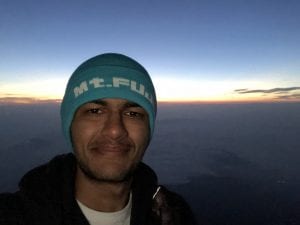
Final Research Overview and Poster
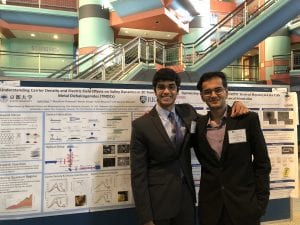
The closing ceremony went smoothly for the most part; it was a lot less nerve racking then the mid-program meeting since this time the audience was primarily just the fellows. I feel as if this time around I was much more confident when I spoke and thus the audience was better able to understand the background and purpose of my research project even though they were all dealing with physics based research topics. In the future, I think the only thing I need to improve upon is talking slower and annunciating my words better so that my speech is easier to follow.
The SCI poster presentation got better as I gained more confidence in presenting my research to more people. At first it was a bit awkward because most of the people were not of a biology background so I had trouble knowing where to begin. However, after a couple of people came up to my poster I was able to thoroughly explain my project even to people with no knowledge of stem cells or microfluidics. For future presentations, I hope to become more comfortable with my work so that I can talk more casually instead of like a robot. I want my presentation to be smoother and flow nicer, but this can only come with more practice. I attended the talks leading up to the poster presentation and they were very interesting. I have listened to plenty of talks before at my lab in the US, but it was nice to hear people discussing topics outside the realm of biology. From the talks, I learned how to better explain a topic so a scientist from almost any field can understand the details of the research project.
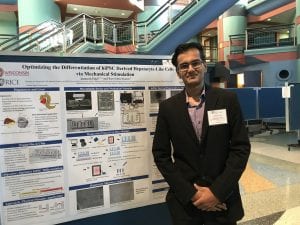
Project Abstract and Poster: Optimizing the differentiation of hiPSC derived hepatocyte-like cells via mechanical stimulation (PDF)
Host Lab: iCeMS facility at Kyoto University
Host Professor/Mentor: Ken-Ichiro Kamei
Introduction: Hepatocytes are essential cells for drug metabolism and thus are a major focal point for pharmaceutical companies. These cells compose over 80% of the liver’s mass and during early embryonic development the liver bud forms adjacent to the heart.
Big Picture: Successful pre-clinical testing requires fully functioning hepatocytes, but there are donor limitations and the quality of the samples can greatly vary. Thus, the solution is to differentiate the hepatocytes from hiPSCs.
Approach: The differentiation process of hiPSCs to hepatocyte-like cells requires both chemical and physical controls. The chemical cues have been heavily researched with promising findings, but the research regarding mechanical stimuli has only recently begun. The idea is to simulate the beating of the heart in vitro since it is believed that this motion may be influencing how the liver bud stem cells differentiate during early embryonic development. A pressure generator will be used to pump air in cyclic intervals underneath the wells on which the hiPSCs adhere to in order to recreate the beating heart effect on a PDMS microfluidic device. After 10 days of continuous stimulus application the cells will be analyzed using qRT-PCR with 96 known genes of mature hepatocytes.
Results: The differentiating hiPSCs were unable to adhere to the PDMS surface or the surface of a standard 96 well tray. After further investigation, it was found that HepG2, cells from a cancerous liver cell line were able to adhere to the PDMS microfluidics device surface.
Discussion: The mechanical stimulus could not be investigated since the hepatocyte-like cells did not adhere to the PDMS surface. Since the HepG2 cells could adhere to the surface and survive for several days it suggests that the issue lies with an inherent weakness of the hiPSCs. A new cell culture media protocol, implemented right before I joined the lab, may also be hindering the ability of the cells to adhere to the surface.
Future Research: The focus in the future should be to investigate the cause of a lack of cell adhesion to the PDMS surface. There are 5 possible problems to consider: possibly toxic chemical residue from the 3D mould, the matrigel coated wells may not be promoting proper adhesion, the inherent weakness of the hiPSCs, the cell media, or the PDMS microfluidics.
Follow-on Project
There are a few ideas that I am considering for a follow-on project to the Nakatani program. I currently lead a team of 20 undergraduates that volunteer to participate in after school science activities with kids from K-5. I think this would be a great opportunity to not only encourage the kids to pursue a stem degree, but also to travel abroad so that they can experience different cultures. We also have study abroad fairs at our college and I am thinking about giving a mini presentation to encourage more applicants to consider the Nakatani Fellowship if they are interested in a career in research or with Japan. I will be meeting with our international coordinator before the fall semester begins and I will talk to her about my idea of presenting what I did over the summer to promote interest in the Nakatani Program. My university also hosts an undergraduate poster presentation session and I think I may be able to present my work that I did over the summer at this event. I will be sure to keep you updated on my follow-on projects as they further develop.
Tips for Future Participants
Pre-Departure
- Make sure to buy enough gifts for everyone in lab (food is the best option)
- Pack light when it comes to clothing, toiletries, or cosmetics as most of these you can buy in Japan
- Plan before you leave what you want to do in Tokyo during the orientation program
- Email your mentor before going to lab and ask if there is anything you should read or prepare before arriving
Orientation Program
- Try to get to know the other fellows as soon as possible
- Travel as much as possible in Tokyo (if your lab is not in the city)
Mid-Program Meeting
- Practice your presentation thoroughly and don’t worry if you don’t have results
- Try to enjoy your time with the Japanese fellows since this is the last time you will be with them
Research Lab
- Always ask questions to your research mentor
- Get involved with lab activities
- Don’t overwork yourself
Living in Kyoto
- Find a bike to get around in the city (Kyoto)
- Shop at a grocery store for the best prices
- Explore the city as much as possible in your free time
- Daiso has great products for very cheap prices (household items or souvenirs)
Language Study
- Talk in Japanese with lab mates or whenever in public situations (shopping)
- Try watching Japanese programs with English subtitles
Gifts/Souvenirs to Buy in Japan
- Face masks or cosmetics (Matsumoto Kiyoshi Drug Store)
- Snacks and other food items (Tokyo Banana)
- Clothing (Shibuya in Tokyo, Dotombori in Osaka, or Kawaramachi in Kyoto)
- Omamori from shrines/temples
- Anime goods (Akihabara or Nakano Broadway in Tokyo)
